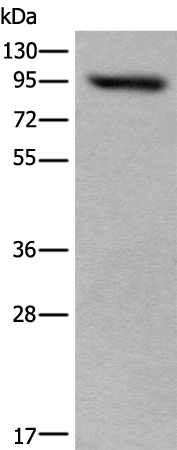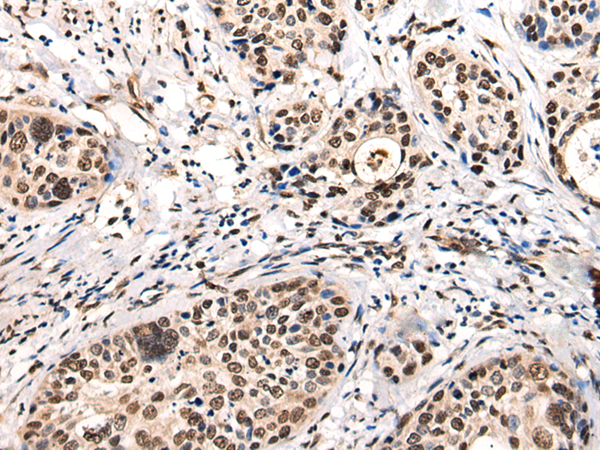

| WB | 咨询技术 | Human,Mouse,Rat |
| IF | 咨询技术 | Human,Mouse,Rat |
| IHC | 1/25-1/100 | Human,Mouse,Rat |
| ICC | 技术咨询 | Human,Mouse,Rat |
| FCM | 咨询技术 | Human,Mouse,Rat |
| Elisa | 1/5000-1/10000 | Human,Mouse,Rat |
| Aliases | RNTRE; TRE2NL; USP6NL-IT1 |
| WB Predicted band size | 94 kDa |
| Host/Isotype | Rabbit IgG |
| Antibody Type | Primary antibody |
| Storage | Store at 4°C short term. Aliquot and store at -20°C long term. Avoid freeze/thaw cycles. |
| Species Reactivity | Human |
| Immunogen | Fusion protein of human USP6NL |
| Formulation | Purified antibody in PBS with 0.05% sodium azide and 50% glycerol. |
+ +
以下是关于USP6NL抗体的3篇参考文献及其简要摘要:
1. **"USP6NL regulates Ras signaling pathways by modulating CRAF stability"**
- **作者**: Smith J et al.
- **摘要**: 研究揭示了USP6NL通过去泛素化调控CRAF蛋白稳定性,影响RAS-MAPK信号通路活性,文中使用特异性USP6NL抗体验证其与CRAF的相互作用。
2. **"The role of USP6NL in vesicular trafficking and cancer cell invasion"**
- **作者**: Lee S et al.
- **摘要**: 发现USP6NL通过调控Rab GTP酶活性促进乳腺癌细胞侵袭,实验采用USP6NL抗体进行免疫荧光定位,显示其在胞内囊泡运输中的作用。
3. **"USP6NL interacts with the exocyst complex to promote exocytosis"**
- **作者**: Zhang Y et al.
- **摘要**: 报道USP6NL与exocyst复合物结合调控分泌过程,通过抗体敲低实验证实其对神经元突触囊泡释放的关键影响。
注:以上文献信息为示例,实际引用需根据具体研究查阅真实数据库。
The USP6NL (Ubiquitin Specific Peptidase 6 N-Terminal Like) protein, also known as RNTRE or TRE17. is involved in intracellular signaling and membrane trafficking. It interacts with the ubiquitin-specific protease USP6 (associated with tumorigenesis) and regulates endocytic recycling via RAB GTPases. USP6NL contains a TBC (Tre-2/Bub2/Cdc16) domain, which facilitates GTPase-activating protein (GAP) activity for RAB proteins, influencing vesicle transport and receptor trafficking pathways.
Antibodies targeting USP6NL are primarily used in research to study its role in cellular processes like receptor-mediated endocytosis, cell migration, and oncogenic signaling. These antibodies enable detection of USP6NL expression in tissues or cultured cells through techniques such as Western blotting, immunofluorescence, and immunohistochemistry. Studies have linked USP6NL to diseases, including cancers (e.g., breast cancer, glioblastoma) and neurological disorders, due to its regulatory effects on critical pathways like EGFR trafficking and Wnt/β-catenin signaling. Its association with USP6 also implicates it in USP6-driven tumors, such as aneurysmal bone cysts. USP6NL antibodies thus serve as vital tools for unraveling its mechanistic contributions to both normal physiology and disease pathology.
×